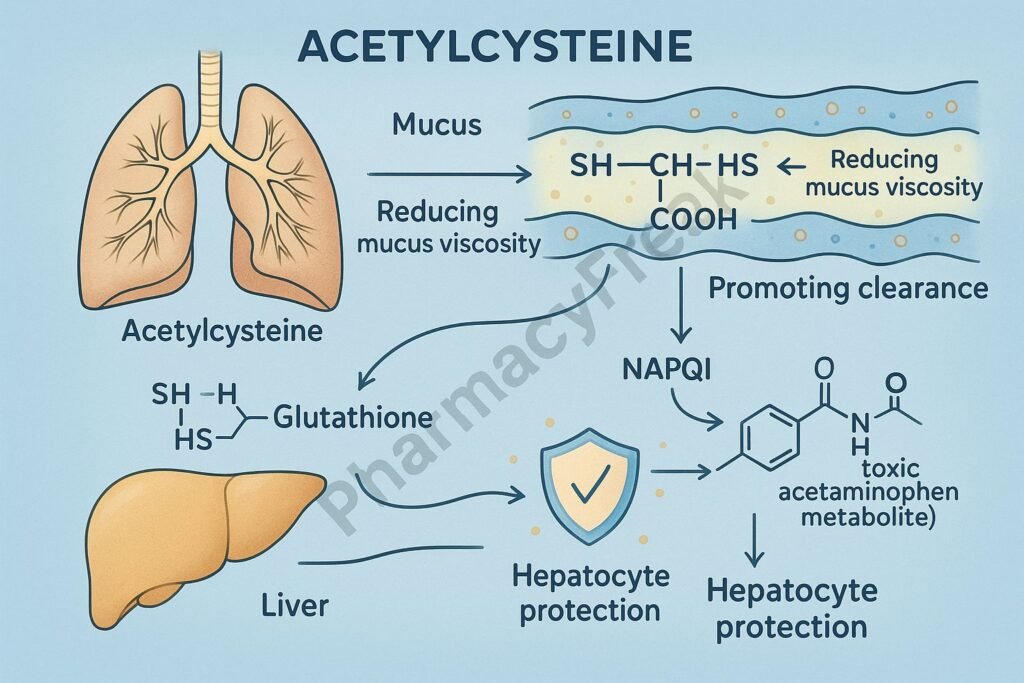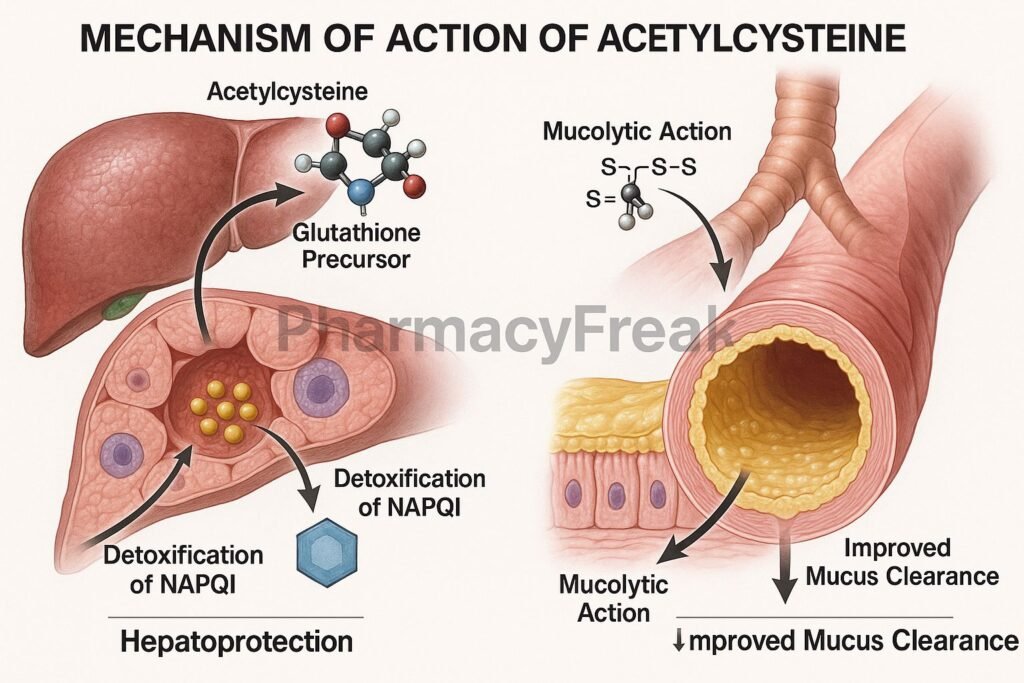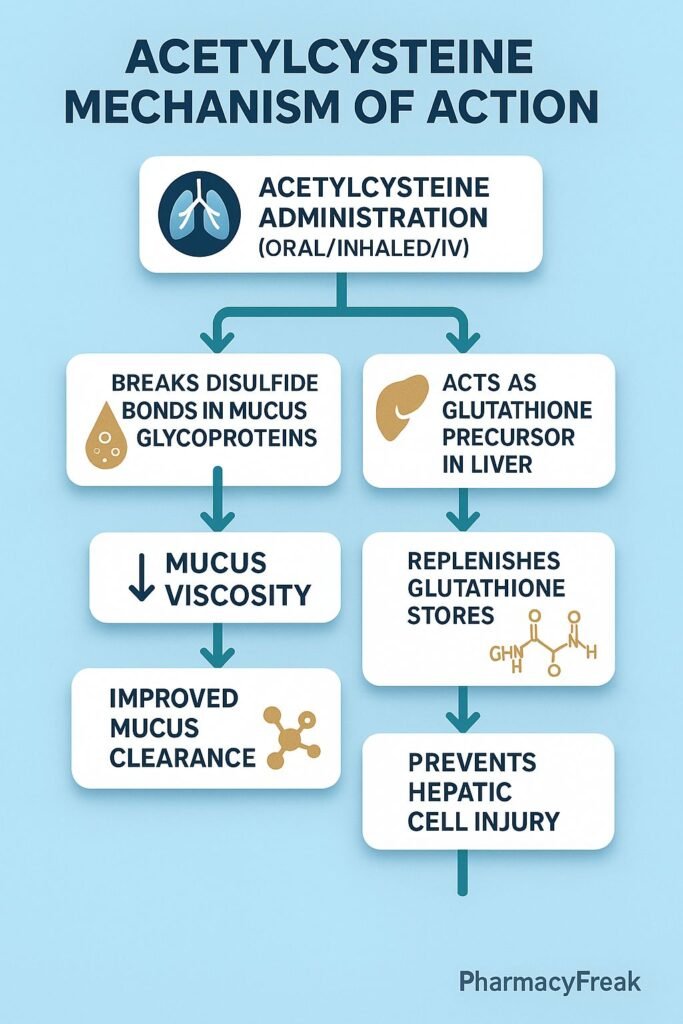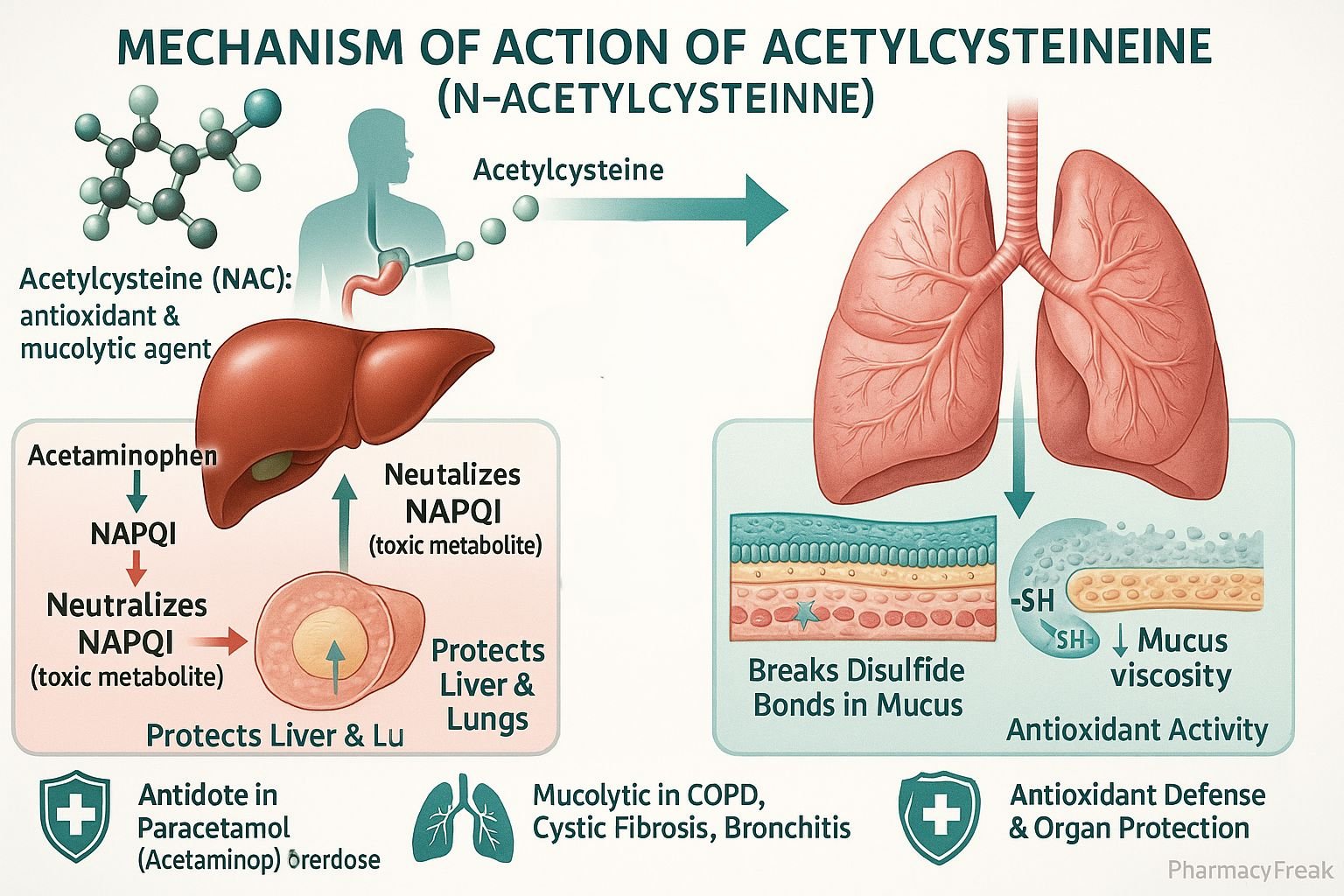Table of Contents
Introduction
Acetylcysteine, also known as N-acetylcysteine (NAC), is a versatile therapeutic agent with mucolytic, antioxidant, and hepatoprotective properties. Mechanism of Action of Acetylcysteine is based on its ability to break disulfide bonds in mucus, replenish intracellular glutathione, and detoxify harmful metabolites such as N-acetyl-p-benzoquinone imine (NAPQI) in acetaminophen poisoning. Clinically, it is used in respiratory diseases with thick mucus, acetaminophen toxicity, and as an antioxidant adjunct in various disorders.


Mechanism of Action (Step-wise)
1. Mucolytic Action
- Acetylcysteine contains a free sulfhydryl (–SH) group.
- This group breaks disulfide bonds between mucin glycoproteins in bronchial secretions.
- The mucus becomes less viscous and easier to expectorate.
2. Antioxidant and Glutathione Precursor
- NAC serves as a precursor for glutathione (GSH) synthesis in cells.
- Glutathione is a major intracellular antioxidant that neutralizes reactive oxygen species (ROS).
- This replenishment protects cells from oxidative stress and free radical injury.
3. Hepatoprotective Role in Acetaminophen Toxicity
- In acetaminophen overdose, the toxic metabolite NAPQI accumulates and binds to hepatocytes.
- Acetylcysteine replenishes glutathione, which conjugates with NAPQI to form a non-toxic compound.
- This prevents liver cell necrosis and hepatic failure.
4. Anti-inflammatory Effects
- NAC reduces cytokine release (e.g., TNF-α, IL-6) and modulates nuclear factor-kappa B (NF-κB) activation.
- These effects contribute to reduced inflammation and oxidative damage in chronic conditions.
5. Overall Effect
- Mucolytic: Thins mucus and eases expectoration.
- Antioxidant: Restores cellular redox balance.
- Hepatoprotective: Prevents hepatic injury in drug overdose.

Pharmacokinetics
- Absorption: Rapid after oral administration; also effective via IV or inhalation.
- Distribution: Widely distributed, especially in lungs, liver, and kidneys.
- Metabolism: Hepatically metabolized to cysteine and glutathione derivatives.
- Excretion: Primarily renal.
- Half-life: 5–6 hours.
Clinical Uses
- Acetaminophen (paracetamol) overdose.
- Chronic bronchitis, COPD, cystic fibrosis (as mucolytic).
- Radiocontrast nephropathy prevention (off-label).
- Adjunct therapy in psychiatric disorders and oxidative stress-related diseases.
- Adjuvant in influenza and pneumonia to reduce mucus accumulation.
Adverse Effects
- Common: Nausea, vomiting, diarrhea, and unpleasant sulfur odor/taste.
- Less common: Urticaria, rash, mild bronchospasm (in inhaled form).
- Serious: Anaphylactoid reactions with IV use (rare, usually self-limited).
Comparative Analysis
| Feature | Acetylcysteine (NAC) | Guaifenesin | Carbocisteine |
|---|---|---|---|
| Mechanism | Breaks disulfide bonds, ↑ GSH | Stimulates respiratory secretions | Modifies mucus viscosity |
| Primary action | Mucolytic + Antioxidant + Antidote | Expectorant | Mucolytic |
| Use in acetaminophen toxicity | Yes | No | No |
| Route of administration | Oral, IV, inhalation | Oral | Oral |
| Additional benefits | Hepatoprotection, antioxidant | Mild cough relief | Respiratory support |
MCQs
1. Acetylcysteine acts as a mucolytic by:
a) Blocking histamine receptors
b) Breaking disulfide bonds in mucus
c) Stimulating surfactant secretion
d) Blocking calcium channels
Answer: b) Breaking disulfide bonds in mucus
2. In acetaminophen overdose, acetylcysteine replenishes:
a) Serotonin
b) Glutathione
c) Dopamine
d) Adenosine
Answer: b) Glutathione
3. The toxic metabolite in acetaminophen poisoning neutralized by NAC is:
a) Noradrenaline
b) NAPQI
c) GABA
d) Dopamine
Answer: b) NAPQI
4. Which route of administration is used in acetaminophen toxicity?
a) Inhalation
b) Oral or IV
c) Intramuscular
d) Subcutaneous
Answer: b) Oral or IV
5. Major adverse effect of IV acetylcysteine is:
a) Hypertension
b) Anaphylactoid reaction
c) Bradycardia
d) Constipation
Answer: b) Anaphylactoid reaction
6. The half-life of acetylcysteine is approximately:
a) 1 hour
b) 3 hours
c) 5–6 hours
d) 10 hours
Answer: c) 5–6 hours
7. Acetylcysteine exerts antioxidant effects by:
a) Inhibiting COX enzymes
b) Increasing glutathione levels
c) Stimulating beta receptors
d) Blocking histamine release
Answer: b) Increasing glutathione levels
8. Acetylcysteine is contraindicated in:
a) COPD
b) Asthma with severe bronchospasm
c) Cystic fibrosis
d) Pneumonia
Answer: b) Asthma with severe bronchospasm
9. The characteristic odor of acetylcysteine is due to:
a) Sulfhydryl group
b) Amine group
c) Carboxyl group
d) Phenolic group
Answer: a) Sulfhydryl group
10. Which of the following is NOT a therapeutic use of acetylcysteine?
a) Paracetamol overdose
b) Mucolytic therapy
c) Bronchodilation in asthma
d) Prevention of contrast nephropathy
Answer: c) Bronchodilation in asthma
FAQs
Q1. How does acetylcysteine help in paracetamol poisoning?
It replenishes glutathione stores, which detoxify the harmful metabolite NAPQI in the liver.
Q2. Is acetylcysteine the same as cysteine?
No, it is the acetylated form of cysteine and acts as a precursor to cysteine and glutathione.
Q3. How is acetylcysteine administered for mucolytic action?
Usually via inhalation or orally, depending on the condition.
Q4. Can acetylcysteine be used in chronic bronchitis?
Yes, it reduces mucus viscosity and oxidative damage in chronic bronchitis and COPD.
Q5. What should be monitored during IV administration of NAC?
Patients should be monitored for allergic or anaphylactoid reactions.
Q6. Is acetylcysteine safe during pregnancy?
Yes, it is generally considered safe and used in cases like acetaminophen toxicity.
References
- Goodman & Gilman’s The Pharmacological Basis of Therapeutics
- Katzung Basic and Clinical Pharmacology
- Harrison’s Principles of Internal Medicine
- WHO Model Formulary and Drug Monographs
Related Internal Links

I am pursuing MBA in pharmaceutical management from NIPER Hyderabad with a strong academic record and proven success in national-level pharmacy entrance exams. I secured AIR 61 in NIPER 2024 (MS/M.Pharm) and AIR 27 in NIPER MBA, along with AIR 147 in GPAT 2024 and AIR 907 in GPAT 2023. I also achieved AIR 6 in AIIMS CRE-2025 for Drug Store Keeper and was selected as a Pharmacist (AIR 61) for ESIC. Additionally, I was the Runner-Up in Round 2 of the EY Case Study Competition.
At PharmacyFreak.com, I aim to guide future pharmacists through expert content, exam strategies, and insightful resources based on real experience and academic excellence.
Mail- harsh@pharmacyfreak.com
